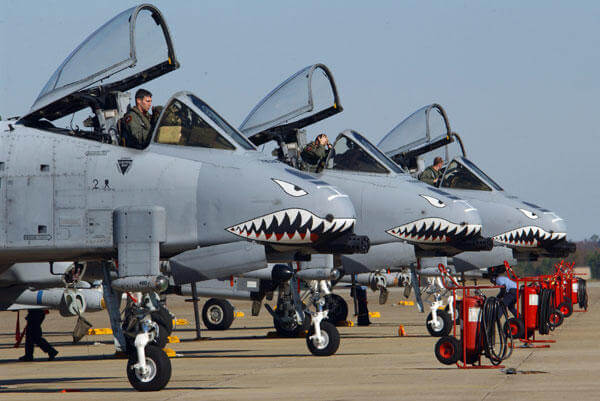Congress cited Russia's invasion of Ukraine as an example of why it's foolish for Air Force leaders to propose killing entire fleets of aircraft such as the A-10 in anticipation future aircraft like the F-35 will take over the missions in time.
Member of the House Appropriations Subcommittee on Defense asked the Air Force's top two leaders Wednesday why they chose to eliminate the A-10 Thunderbolt and the U-2 Dragon Lady fleets as near term conventional threats remain in places like Russia and North Korea.
Air Force Secretary Deborah Lee James and Air Force Chief of Staff Gen. Mark Welsh told the committee members the flattening of the defense budget had left them little choice. The services has to take risks to ensure modernization programs like the F-35 are delivered and airmen keep getting paid, Welsh and James said.
The Air Force proposed in its 2015 budget request to retire the A-10 and U-2 fleets in order to account for the cuts associated with sequestration. Air Force leaders have already received significant push back from lawmakers in districts where those aircraft are stationed, and from Guard and Reserve advocacy groups.
Trying to keep fleets alive with minor reductions to a broad selection of aircraft versus whole sale cuts to specific fleets would end up costing the service more and hurt the Air Force's overall readiness, Welsh said. In retiring the A-10, the Air Force anticipates saving about $3.7 billion over time and about a half billion dollars by avoiding upgrades, Welsh said.
The Air Force has chosen to prioritize aircraft that can complete multiple missions. The A-10 is limited ot the close air support mission -- a mission the Air Force says the F-16 can fulfill in the near term and the F-35 will complete in the far term. By eliminating the A-10 fleet, the Air Force will save money by eliminating its maintenance and support footprint.
"Everything does hurt. Everything has a major impact on us," Welsh told members of the House Appropriations Subcommittee on Defense. "Divesting the A-10 has an impact, divesting the U-2 has an impact."
Lawmakers also asked about the Air Force's plan to recapitalize the service's command and control aircraft to include the Airborne Warning and Reconnaissance System and Joint Surveillance Target Attack Radar System. Specifically, Welsh was asked why it was necessary to deactivate the seven AWACS aircraft stationed at Tinker Air Force Base, Okla.
The Air Force chief of staff explained to the committee that the service must retire some of the aircraft in order to pay for the upgrades to the rest of the fleet.
"We have got to recapitalize it somehow," he said of the plane, first flown in the 1970s. "Within the Air Force budget the only option came up with to modernize that fleet is eat some of the aircraft to pay for the modernization."
Welsh said other Air Force leaders don't like taking on the risk of fewer aircraft in the future, but understand these steps must be taken in order to keep the aircraft flying into the 2020s.
"If we want this capability in 2023 and beyond we have to do something now," he said.
The JSTARS, which the Air Force operates with the Army, was first fielded in 1991 to provide theater commanders with information.
The Air Force's proposed $109 billion budget for 2015 includes $7 billion for aircraft modifications, in addition to facility repairs and training range improvements. The money also would go toward two additional F-35As, 12 MQ-9 Reapers and 10 C-130s.
Welsh and James said the U-2 will be replaced by Global Hawk, a high-altitude, long-endurance surveillance drone, while the MQ-9 Reaper would eventually replace the Predator.
James said the Air Force is also taking a chance in terms of the small pay raise being offered in the 2015 budget, as well as other benefit reductions that it and the other services will be living with.
But she called the measures reasonable in view of the tight budgets and the last decade of significant pay raises and improved benefits.
"We have had substantial growth (in pay) in the last 12 to 14 years," James said, in some cases meeting and exceeding pays in the private sector. "But I think we're now at a point, given that our recruiting is strong, our retention is strong ... we can afford to take that risk and slow that growth in compensation."
-- Bryant Jordan can be reach at bryant.jordan@monster.com
-- Michael Hoffman can be reached at mike.hoffman@monster.com



























